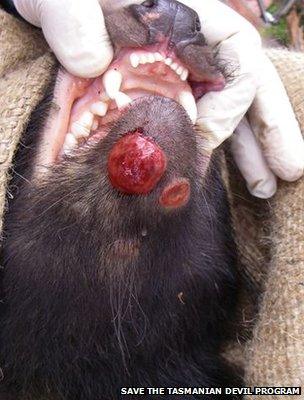Tasmanian devils' killer disease genome mapped
- Published

The contagious cancer has led to the devil population declining by up to 90% in some areas
Researchers have sequenced the genome of the killer disease that is driving the remaining wild populations of Tasmanian devils towards extinction.
They hope the genetic data will offer clues on how to suppress the spread of Devil Facial Tumour Disease (DFTD), which is transmitted via biting.
Since DFTD was first recorded in 1996, populations in some areas are estimated to have declined by up to 90%.
Details of the research have been published in the journal Cell, external.
DFTD refers to a fatal condition that is characterised by the appearance of facial tumours.
As these develop into large cancerous growths, the animal finds it hard to eat. As it becomes weaker, it is unable to compete with other animals for food.
Researchers say that affected animals appear to die within three to five months of the lesions first appearing.
The international team of scientists that sequenced the genome (complete set of genetic material) of DFTD built on earlier work that sequenced the genome of the Tasmanian devil itself, and the combined work could play a role in preventing the continual spread of the contagious cancer.
"We can now look for mutated pathways that might be responsible for the cancer's growth, which may offer potential targets or ideas for therapeutic interventions that could help the devils in the wild," explained co-author Elizabeth Murchison, a researcher at the Wellcome Trust Sanger Institute, Cambridge, UK.
"It has also allowed us to identify a number of genes that have a number of mutations, which makes it different to a normal devil's genome," she told BBC News.
"Of course, we are also keen to develop vaccines that help the devils' bodies detect that the cancer is foreign, and by using these genes that are different between the cancer and the host, they may present ideas for developing vaccines."
'Immortal devil'
Dr Murchison added that the sequencing also allowed the researchers to understand the dynamics of the disease.
"Because the cancer is spread by living cancer cells, it actually arose from one individual devil," she said.
By using "genetic detective work", Dr Murchison and the team said the disease first arose in a female more than 15 years ago.
"As far as we know, it was just a normal, wild Tasmanian devil but for some reason it developed this tumour that became transmissible."
As the cancer cells were passed from one animal to another over the years, the original host was nicknamed the "immortal devil".
"She is, in a way, living on long after her own death," observed Dr Murchison.
Previous research revealed that DFTD was spread by biting, which played a major part in the devils' social interaction, such as mating and competing for food.
"Normally, a cancer that arises within the body of one person dies when that person dies," she explained. "It doesn't normally have an existence outside the body of its host.
"What is so unusual about the devils' cancer is that it has been able to survive after the death of its host.
"This has been facilitated by the fact that devils do bite each other, which has created a route for the transmission for the cancer."
The rapid spread of the contagious DFTD saw a steep decline in the wild population of the devils, prompting the Australian government in May 2009 to list the species (Sarcophilus harrisii) as Endangered.
As the world's largest marsupial carnivore is only found in the wild within Tasmania, the species is also listed as Endangered by the IUCN's global Red List of Threatened Species.
The outlook for the devils was so bleak that it prompted the government-backed Save the Tasmanian Devil Program, external to establish an "insurance population" in 2005.
This involved placing more than 270 disease-free devils in captivity in case it became necessary in the future to re-establish a healthy wild population.
But Dr Murchison added: "My goal is to do something to stop the spread of the disease in the wild before it is too late, [but] the wild population is declining at a very rapid rate, and there are some fears that the species in the wild could go extinct in 20-30 years.
"It would be impossible to re-introduce devils into the wild until we were certain that there were no diseased devils left out there, otherwise the [reintroduction] would be pointless because the disease would just come back again."
Explaining why it was important to continue research into developing a treatment for DFTD, she said: "Even if we do have to wait to re-introduce devils into the wild, it is going to be really important to be able to prevent those devils from getting the disease, and suppress the disease, just in case there are still reservoirs of it still left in the wild."
- Published27 June 2011